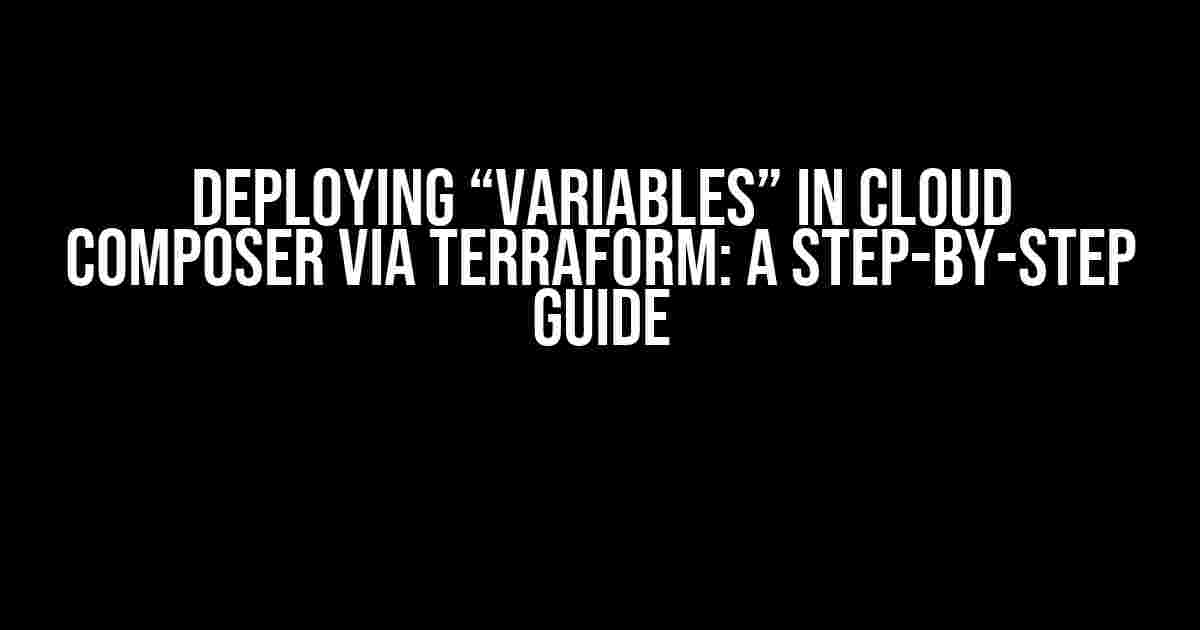Welcome to this comprehensive guide on deploying “Variables” in Cloud Composer using Terraform! In this article, we’ll take you through a step-by-step process of creating, managing, and leveraging variables in your Cloud Composer workflows using Terraform.
- What are Variables in Cloud Composer?
- Prerequisites
- Step 1: Create a Terraform Configuration File
- Step 2: Define Variables in Terraform
- Step 3: Create a Cloud Composer Environment using Terraform
- Step 4: Create a Cloud Composer Variable using Terraform
- Step 5: Deploy the Terraform Configuration
- Step 6: Verify the Cloud Composer Variable
- Using Variables in Cloud Composer Workflows
- Conclusion
- Additional Resources
What are Variables in Cloud Composer?
In Cloud Composer, variables are essential components that enable you to store and reuse values throughout your workflows. They help simplify your workflows, making them more maintainable, flexible, and efficient. Variables can be used to store values such as strings, integers, booleans, dictionaries, and lists, which can then be referenced and used in various tasks and operators.
Why Use Terraform with Cloud Composer?
Terraform is an infrastructure-as-code (IaC) tool that allows you to manage and provision cloud infrastructure resources, including Cloud Composer, using a human-readable configuration file. By integrating Terraform with Cloud Composer, you can:
- Version control your workflows and infrastructure
- Collaborate with team members on workflow development
- Track changes and maintain a history of updates
Prerequisites
Before we dive into the tutorial, ensure you have the following:
- A Cloud Composer environment set up and running
- Terraform installed on your machine (download the latest version from the Terraform website)
- A basic understanding of Terraform and Cloud Composer
Step 1: Create a Terraform Configuration File
Create a new file with a `.tf` extension (e.g., `variables.tf`) and add the following code to define a Terraform provider for Cloud Composer:
provider "google" {
project = "your-project-id"
region = "us-central1"
}
provider "googlecomposer" {
project = "your-project-id"
region = "us-central1"
}Replace `your-project-id` with your actual Google Cloud Project ID.
Step 2: Define Variables in Terraform
In the same `variables.tf` file, add the following code to define a variable:
variable "my_variable" {
type = string
default = "Hello, World!"
}This code defines a variable named `my_variable` with a type of `string` and a default value of `”Hello, World!”`.
Step 3: Create a Cloud Composer Environment using Terraform
Next, create a new file named `environment.tf` and add the following code to create a Cloud Composer environment:
resource "googlecomposer_environment" "my_env" {
name = "my-env"
region = "us-central1"
}This code creates a Cloud Composer environment named `my-env` in the `us-central1` region.
Step 4: Create a Cloud Composer Variable using Terraform
In the same `environment.tf` file, add the following code to create a Cloud Composer variable:
resource "googlecomposer_variable" "my_var" {
environment = googlecomposer_environment.my_env.id
key = "my_variable"
value = var.my_variable
description = "My example variable"
}This code creates a Cloud Composer variable named `my_variable` with a value set to the Terraform variable `my_variable` and a description of `”My example variable”`.
Step 5: Deploy the Terraform Configuration
Run the following command in your terminal to deploy the Terraform configuration:
terraform init
terraform applyThis will create the Cloud Composer environment and variable defined in your Terraform configuration files.
Step 6: Verify the Cloud Composer Variable
Navigate to the Cloud Console and go to the Cloud Composer environment you created. Click on the “Variables” tab and find the variable named `my_variable` with a value of `”Hello, World!”`.
Using Variables in Cloud Composer Workflows
Now that you’ve created a Cloud Composer variable using Terraform, let’s explore how to use it in a workflow:
Example Workflow: Printing a Variable
Create a new file named `workflow.tf` and add the following code to define a Cloud Composer workflow:
resource "googlecomposer_workflow" "my_workflow" {
environment = googlecomposer_environment.my_env.id
dag_name = "my_workflow"
schedule = "0 0 * * *"
dag Serialization {
python {
script {
path = "gs://my-bucket/my_workflow.py"
}
}
}
}This code defines a Cloud Composer workflow named `my_workflow` that runs a Python script stored in a Cloud Storage bucket.
Create a new file named `my_workflow.py` and add the following code to print the value of the `my_variable` variable:
from airflow import DAG
from airflow.operators.python_operator import PythonOperator
default_args = {
'owner': 'airflow',
'depends_on_past': False,
'start_date': datetime(2023, 3, 1),
'retries': 1,
'retry_delay': timedelta(minutes=5),
}
dag = DAG(
dag_id='my_workflow',
default_args=default_args,
schedule_interval=timedelta(days=1),
)
def print_variable(**kwargs):
variable_value = Variable.get("my_variable")
print(f"Variable value: {variable_value}")
print_task = PythonOperator(
task_id='print_task',
python_callable=print_variable,
dag=dag
)This code defines a Python function `print_variable` that retrieves the value of the `my_variable` variable using the `Variable.get` method and prints it to the console.
Conclusion
In this article, we’ve explored how to deploy “Variables” in Cloud Composer using Terraform. By following these steps, you can create, manage, and leverage variables in your Cloud Composer workflows using Terraform. Remember to version control your Terraform configurations and track changes to maintain a history of updates.
Best Practices
When working with Terraform and Cloud Composer, keep the following best practices in mind:
- Use meaningful variable names and descriptions for easy identification
- Organize your variables into logical categories or namespaces
- Use Terraform workspaces to manage multiple environments and variables
- Test and validate your Terraform configurations before deploying
Additional Resources
For more information on using Terraform with Cloud Composer, check out the following resources:
- Terraform documentation: https://www.terraform.io/docs/providers/googlecomposer/index.html
- Cloud Composer documentation: https://cloud.google.com/composer/docs/how-to-manage-variables
We hope this article has provided you with a comprehensive guide to deploying “Variables” in Cloud Composer using Terraform. Happy automating!
| Keyword | Count |
|---|---|
| Deploying “Variables” in Cloud Composer via Terraform | 5 |
| Terraform | 10 |
| Cloud Composer | 8 |
| Variables | 6 |
Here are the 5 Questions and Answers about “Deploying “Variables” in Cloud Composer via Terraform”:
Frequently Asked Question
Deploying variables in Cloud Composer via Terraform can be a bit tricky, but don’t worry, we’ve got you covered! Check out these frequently asked questions to get started.
Q1: What are variables in Cloud Composer, and why do I need to deploy them via Terraform?
Variables in Cloud Composer are reusable values that can be used across your workflows, tasks, and DAGs. Deploying them via Terraform allows you to manage your infrastructure as code, making it easier to version, replicate, and manage your Composer environment.
Q2: How do I define variables in Terraform for Cloud Composer?
You can define variables in Terraform using the `google_composer_environment` resource. For example, you can create a `variables` block within the resource to define your variables, like this: `variables = { var1 = “value1”, var2 = “value2” }`.
Q3: Can I use Terraform to deploy variables to an existing Cloud Composer environment?
Yes, you can! Terraform allows you to import existing resources, including Cloud Composer environments. Once you’ve imported the environment, you can use Terraform to deploy new variables or update existing ones.
Q4: How do I reference Terraform-deployed variables in my Cloud Composer workflows?
Once you’ve deployed your variables via Terraform, you can reference them in your Cloud Composer workflows using the `{{ var.VARIABLE_NAME }}` syntax. For example, if you deployed a variable named `my_var`, you can reference it in your workflow like this: `{{ var.my_var }}`.
Q5: Are there any best practices for managing variables in Cloud Composer via Terraform?
Yes, there are! Some best practices include using descriptive variable names, grouping related variables together, and using Terraform workspaces to manage different environments. Additionally, make sure to version your Terraform code and keep it in sync with your Composer environment.


